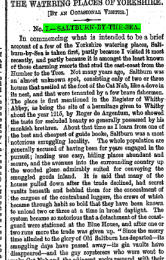Discovering Saltburn's rich heritage and varied history.
Saltburn by the Sea has a rich and varied tapestry of historical development. Although Saltburn's most obvious features are of Victorian origin, its history goes back much further. There is evidence that it was inhabited by a hermit in the thirteenth century and even earlier, during Roman times, it was the site of a fortified Roman signalling station. Saltburn's more covert history lies in smuggling and the town is immensely proud of its famous smuggling past. The resort of Saltburn by the Sea was founded by the Victorian entrepreneur Henry Pease and the legacy of his vision is the Station complex, Zetland Hotel, Pier, Cliff Lift and Valley Gardens as well as the so called "jewel streets" along the sea front. Today Saltburn's Victorian heritage is brilliantly preserved whilst modern Saltburn presents an excellent surfing beach so that recent years have seen the development of a large community of surfers.
Inventing the Seaside
The idea of taking a seaside holiday dates back to the 18th century when the health benefits of fresh air and sea water were first recognised. Initially these benefits were enjoyed only by those who had the time and private means to venture to the English coast in search of a holiday in a congenial setting beside the sea. However the enjoyment of relaxtion and recreation on the shore soon became popular among all social classes and this popularity went hand-in-hand with the invention and development of the seaside 'resort' as a place to seek out leisure and pleasure.
An essential pre-condition for the rapid growth of seaside resorts in the latter part of the 18th century and primarily in the 19th century was space.
Britain possessed an extensive coastline which had few other uses apart from as the location of fishing ports, and which could not be privately controlled since ownership of the shoreline and beach between high and low tide was invested in the Crown.John Urry. 'The Tourist Gaze'
To satisfy demand resorts were developed around the coastline to suit a variety of budgets and tastes. Intended to lure those seeking health, leisure and pleasure experiences they were deliberately designed to make the 'resort experience'occassions that would be enjoyed and returned to yearly, making the seaside holiday integral to the British way of life and cultural experience.
The practice of sea bathing dates back to the late 17th century with members of the medical profession already advocating its benefits as a cure for a variety of ailments. As the prestige of the medical profession rose, advice from such sources began to influence a significant minority of the educated and leisured and Sir John Floyer's History of Cold Bathing had reached its fifth edition by 1722. Promoted by the medical profession, the practice gained popularity as part of the growing fashionable concern for the pursuit of health, leisure and pleasure among the upper classes of 18th century English society. By 1705 Scarborough - which can probably claim to be the earliest English seaside resort - was said to attract most of the gentry from the North of England and Scotland in the summer season and by the 1730's Scarborough, Margate and Brighton, at least, were developing recognisable sea bathing seasons.
The first forty years of the nineteenth century saw a considerable expansion in seaside holiday demand. From the 1830's and 40's the railways provided direct access to the seaside. The journey to the coast became faster, easier, cheaper and more comfortable. By the mid 1840's a variety of options existed on many lines, from the day or week-end excursion to the monthly tourist ticket. The working class seaside visitor was a phenomenon of the railway age which made the development of the working class holiday possible by providing facilities for cheap mass transport. Although the standard fees remained out of his reach, cheap fares on special occasions attracted the working class day tripper to the coast. By 1848 it was estimated that 250,000 people visited Brighton each year.
Silent film clips from the British Film Institute which a day on Brighton Beach in 1896. Of particular interest is the type of clothing worn and the activities being 'enjoyed'.
In the 1871 census out of 56 watering-places mentioned 48 are on the seaside, including Scarborough and Whitby. The 1900-1901 edition of Seaside Watering Places: A Description of the Coasts of England and Wales, Channel Islands, and the Isle of Man, Including the Gayest and the Quietest Places - a guide book which, for a florin, told turn-of-the-century keep-fit fanatics which resort to visit - sees the first mention of Saltburn by the Sea.
"A Visit to the Seaside" by George Albert Smith was the first motion picture exhibited to utilise Kinemacolour, filmed in 1908. It depicts a day at Brighton beach. Unfortunately I've not been able to find the full movie but fragments remain and can be watched below.
Research by Rebecca Hilton. Collecting primary source materials, articles and extracts from books related to the development of both Saltburns and trying to validate them has offered conflicting information, much of which is often difficult to validate as many sources can prove to be unreliable e.g. newspapers or census data. Every effort has been made to ensure that the information on the history of the town presented here is as accurate as possible.


